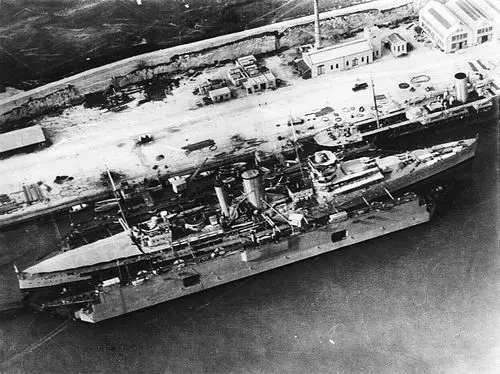Floating Dock Bermuda
If you look out from
Spanish Point, you will see a large chunk of rusted iron and frames lying on the water a little offshore. Many Bermudians today are not even aware of its significance and take it more as an eyesore and an obstacle to boats approaching the nearby harbor.
This used to be the second largest floating dock in the world that was brought in from England in June 1869. The dock was as an integral part of the Royal Naval Dockyard that was built by the British navy and served as part of its defense infrastructure.
So how did this floating dock, named as HM Floating Dock landed up in Bermuda and now lying as a massive piece of junk on the Spanish Point water area?
In the early 1800s when the construction of the Royal Naval Dockyard in Bermuda's Ireland Island began, the British Navy required a dock here to accommodate large warships. They initially conceived the idea of making a dockyard with the help of Bermuda limestone.
HMS York in Admiralty Floating Dock No. 1 at
HM Dockyard Bermuda in 1934
Photo: British Government (Royal Navy), Wikimedia Commons
Later they gave up the idea because the Bermuda rocks were porous in nature and also heterogeneous. But they needed a dock so that the ships did not require to go all the way back to England after serving the water areas in the Western Atlantic.
It was the director of Royal Naval Dockyard Colonel Clarke who then suggested that a floating dock to be constructed as per the new designs from Campbell Johnstone and Company of England. The suggestion was quickly approved and the construction began in August 1866 on river Thames.
In May 1869, the construction of the world's second largest floating dry dock was finally completed by the company which engaged some 1,400 workers for the job. The floating dock had a size of over 47,000 square feet with 381-feet in length and 123-feet as the maximum width, and a depth of 74-feet. It could easily accommodate ships up to 370-foot long and 25-foot wide.
Now the next step was to tow this huge structure from England to Bermuda along the Atlantic water route that was 3,985 miles long. The floating dock weighed some 8,600 tons. On June 24 1869 the journey began from England along the Atlantic.
The floating dock was towed by two ships HMS Northumberland and HMS Agincourt. They were assisted by HMS Warrior and HMS Black Prince. Another ship HMS Terrible guided the stern. After 35 days of towing, the floating dock finally reached Bermuda on July 27, 1869. It then went on to serve the Royal Navy in Bermuda until 1906.
By that time the new generation warships were put into use by the British and the floating dock could no longer serve the purpose. It was then sold out to a German company. After dismantling it partially, while it was being towed away, it fell into a gale and broke loose. It then got stuck in a reef near the Spanish Point from where it could never be removed.
The floating dock was abandoned in 1908. Although Bermuda government even tried to break it apart in 1950 by using dynamite in order to clear up the nearby harbor area, the attempt was unsuccessful. Today from the Spanish Point shore, you can see this large chunk of rusted iron lying on the water.
|
 By Raj Bhattacharya By Raj Bhattacharya
Raj, a seasoned travel writer and Bermuda destination expert, has extensive global travel experience. This website reflects his profound insights, garnered over nearly two decades of dedicated findings and research on the island. Raj has assisted countless Bermuda-bound visitors by providing direct, personalized responses to their queries and imparting his wealth of knowledge through this platform. This site serves as an indispensable guide for those seeking informed and reliable insights into Bermuda's treasures.
|
Related Articles
|
Visitors' Reviews and Comments
David Michael Westmore (October 2023)
The photograph shown is that of the second floating dock at Bermuda which was designated Admiralty Floating Dock No.1 which was designed by Clark & Standfield and built by Swan and Hunter Ltd, Newcastle upon Tyne in 1900. It had a lifting power of 16,500 Long tons and length of 545 ft.
The dock you are describing was the first floating dock in Bermuda which was designed and built by Campbell and Johnstone, Woolwich, in 1866. Campbell's design was unique in that it was of semi circle section to assist with careening whereas Admiralty Floating Dock No.1 had a conventional rectangular section.
|

 By Raj Bhattacharya
By Raj Bhattacharya